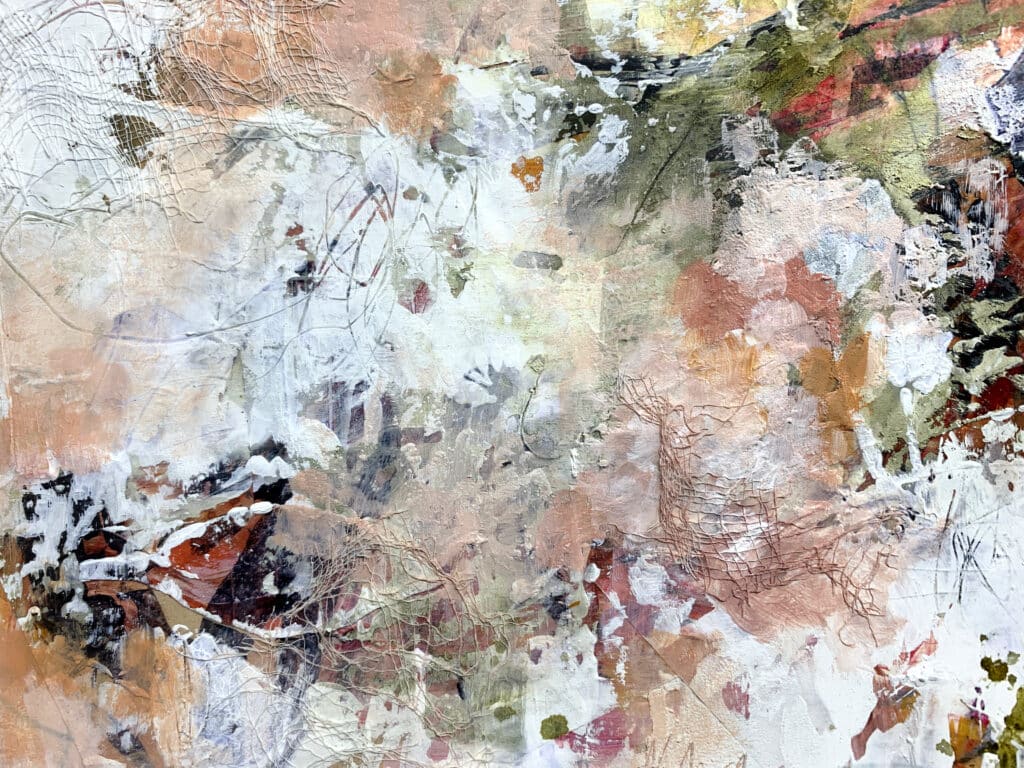Layer 1: Setting the Foundation
1. Express Your Thoughts
- Process: Write down your thoughts and emotions. Scribble words or doodles with pencils and pastels.
- Pointer: Let this be raw and intuitive. Think of this step as creating a personal connection with your art.
2. Unleash Wild Marks
- Process: Choose 2-3 muted light colors and one dark color for contrast. Use a round brush to make fast, spontaneous marks, focusing on the center. Add gesso if needed.
- Pointer: Don’t overthink this. Let go of control and embrace the randomness of your strokes.
3. Splash Watercolors
- Process: Use a wide mop brush to splash watercolors onto the canvas, allowing it to drip and move over the acrylics.
- Pointer: Observe how the watercolor interacts with the acrylics. Let the flow guide your movements.
Layer 2: Deepening the Marks
4. Smudge and Spread
- Process: Make marks with charcoal, then use a wet brush to smudge and spread it. Add black pastel marks and blend with gesso to create grey tones.
- Pointer: Play with the pressure and water to explore different effects. Smudge freely.
5. Bold Marks with Handmade Brush
- Process: Use a handmade brush (e.g., made from branches) dipped in ink to create bold black marks.
- Pointer: Feel the organic, raw nature of the brush, and let the marks feel untamed.
6. Graphite Scribbles
- Process: Scribble with a pencil or graphite stick. Move the graphite around with a semi-dry brush.
- Pointer: Scribbling adds energy to the composition—explore the balance between chaos and control.
Layer 3: Playing with Contrast
7. Spread Acrylics
- Process: Add one acrylic color (and white if needed). Use a big round brush to spread it, leaving spaces where previous layers peek through. Scratch with a pointed tool to reveal what’s underneath.
- Pointer: Use this as a moment of restraint—let the layers breathe while still making bold statements.
8. Pastels and Moppy Brush
- Process: Make marks with pastels, then blend them with a big mop brush, holding it at the end for less control.
- Pointer: Allow freedom in your movements, embracing imperfections and natural strokes.
9. Watery Pools
- Process: Add more watercolors, allowing them to create pools, drips, and splashes. Splash coffee paint for added texture.
- Pointer: Don’t shy away from mess—let the colors mix, even get muddy, to add complexity.
Layer 4: Moving into Refinement
10. Refining with Acrylic
- Process: Add another acrylic color, spreading it around but letting the previous layers show.
- Pointer: Use this layer to bring clarity to areas that feel too chaotic. Find balance.
11. Reveal Layers with Tools
- Process: Use a color shaper to move the paint and reveal hidden layers.
- Pointer: This is about discovering what’s underneath—be playful yet deliberate in your approach.
12. Scratch New Marks
- Process: Use a pointed tool to scratch into the paint and expose earlier layers.
- Pointer: Think of this as carving into the work, adding dimension and texture.
Layer 5: Bringing in Contrast
13. Contrasting with Soft Pastels
- Process: Add burnt sienna, browns, or reddish tones with soft pastels. Scribble curvy lines and blend with a brush.
- Pointer: This layer introduces warmth and contrast, softening areas that feel harsh.
14. White Accents
- Process: Add white marks with pencils or soft pastels, creating lines, shapes, and scribbles.
- Pointer: Think of these as light touches, adding subtle details to brighten the composition.
15. Zoom In with Graphite
- Process: Focus on small areas and add details with a mechanical pencil.
- Pointer: This is where you refine the tiny details that pull the viewer in.
16. Scratching with Precision
- Process: Use a pointed knife to scratch fine marks into the surface.
- Pointer: Create intricate patterns or designs that contrast with the broader strokes.
Layer 6: Final Refinements
17. Charcoal Powder
- Process: Sprinkle charcoal powder over the surface and spray to fix it.
- Pointer: This step adds a moody, atmospheric texture—use it sparingly.
18. White on White
- Process: Make subtle white marks with soft pastels for a barely-there effect.
- Pointer: This creates delicate highlights, giving your piece a dreamy, light quality.
19. Textured Prints
- Process: Dip a small round brush in black acrylic paint, apply it to palette paper, then press the paper onto your artwork to transfer textured lines.
- Pointer: These broken lines add a sense of rough texture, grounding the overall piece.
20. Expressive Black Lines
- Process: Use a rigger brush dipped in black paint to make bold, expressive lines across the canvas.
- Pointer: Move your hand freely and trust your instincts—these lines should feel spontaneous.
21. Resist & Flow Marks
- Process: Apply white oil pastel and go over it with watercolor for a resist effect. Add more watercolor splatters.
- Pointer: Watch how the pastel resists the watercolor, creating dynamic tension between layers.
Final Layer: The Playground of Refinement
22. Edit the Chaos with White
- Process: Use white and one additional color to paint over areas you want to refine, letting previous layers peek through. Scratch through the paint with a pencil to create final marks.
- Pointer: This is your final chance to curate your work—simplify where needed, but keep the essence of each layer alive.
23. Cut Out Abstract Pieces
- Process: Use a composition window to isolate sections of the painting you love. Cut these out to create smaller abstract pieces.
- Pointer: Think of this as harvesting moments from your art—find parts that feel complete on their own.




